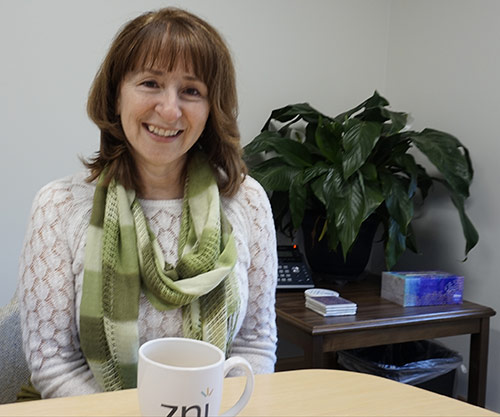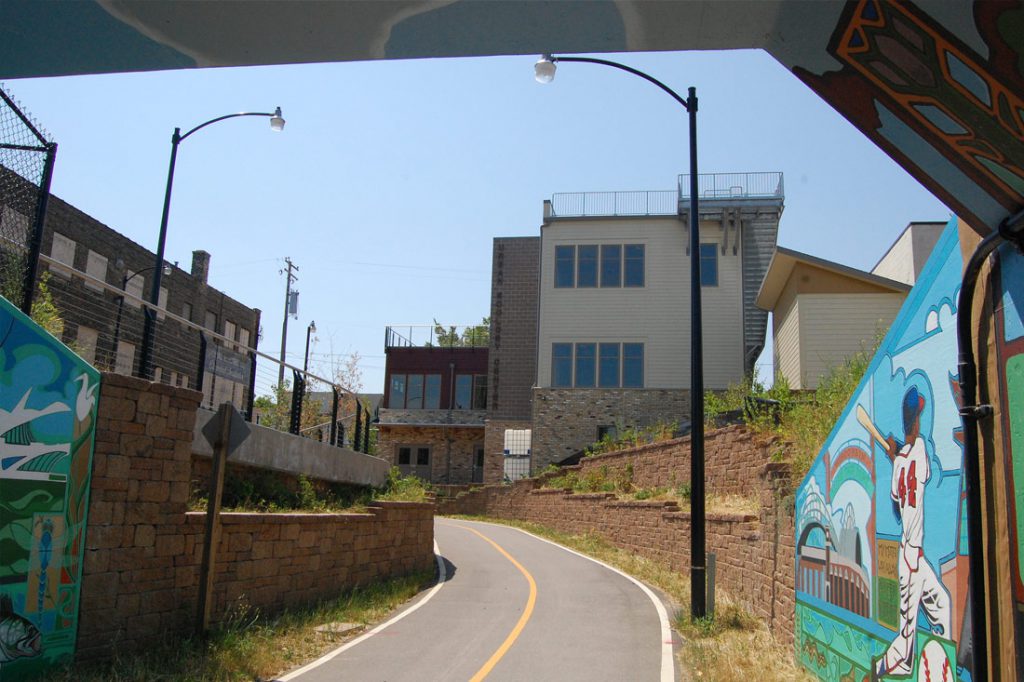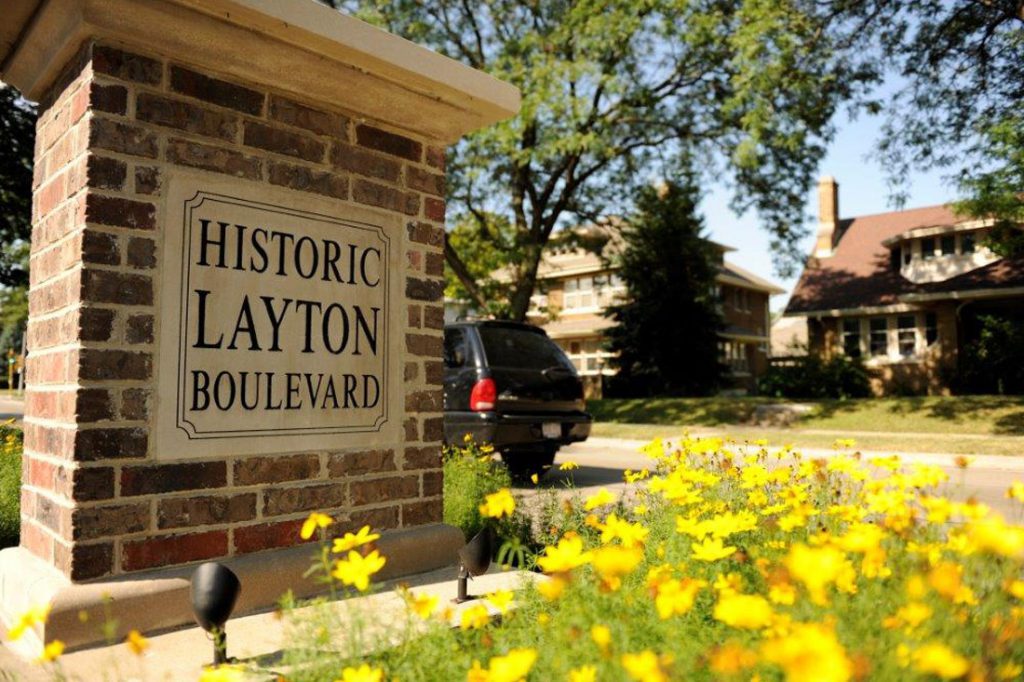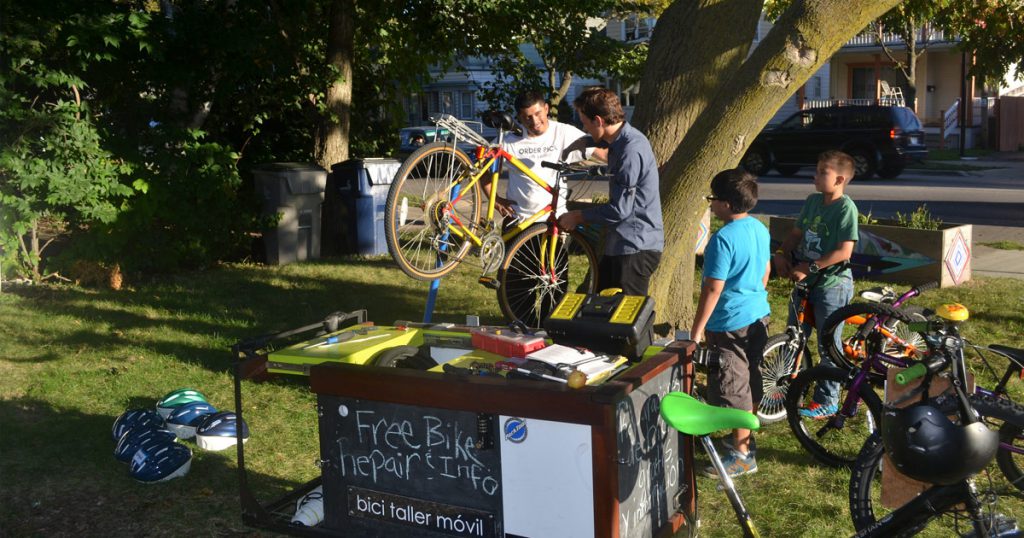Zilber Initiative Helps Near South Side
Home ownership, retail corridors revived in Silver City, two other neighborhoods.
In February, Leticia Muñoz Hernandez plans to open a new eatery in a building that is now being renovated on National Avenue in Silver City. She is excited about the restaurant, which will serve traditional American breakfasts and, likely, some dishes that incorporate Hispanic flavors. She would also like to offer some healthy options.
Muñoz Hernandez has not settled on a name yet, but wants to include the Iroquois word “orenda,” which refers to the spiritual force that motivates one to make changes in oneself, the world or a place.
That concept fits well with the work Layton Boulevard West Neighbors has done as part of the Zilber Neighborhood Initiative. LBWN is a community development nonprofit operating in Silver City and the two neighborhoods to the south, Burnham Park and Layton Park.
LBWN is helping Muñoz Hernandez with her new venture as part of its commercial corridor revitalization work.
Revitalizing the Silver City commercial corridor was one of the goals of LBWN’s quality of life plan, created as part of its participation in ZNI. In 2010, the Zilber Family Foundation, founded by the late philanthropist Joe Zilber, chose the three Layton Boulevard West neighborhoods as the third area for the initiative. By that time, community planning was well underway in Lindsay Heights and Clarke Square, the first two neighborhoods Zilber selected for the 10-year $50 million investment in central city revitalization.
LBWN came to the foundation’s attention when then-executive director Charlotte John-Gomez participated in an early planning phase in neighboring Clarke Square.

Charlotte John-Gomez was the executive director of Layton Boulevard West Neighbors for 16 years from 1999 to 2015. Photo by Andrea Waxman/NNS.
“Charlotte was a very persuasive advocate for our considering LBWN and the neighborhoods that it serves” for ZNI, said Susan Lloyd, the foundation’s executive director from 2008 until July.
“We took a deeper and longer look at Layton Park, Burnham Park and Silver City as an area where the foundation could support three neighborhoods through a very, very capable nonprofit organization,” Lloyd said.
She noted that these neighborhoods complemented the mix of neighborhoods in which the foundation was investing. Clarke Square and Lindsay Heights were both “very distressed and had a lot of challenges, many of which have been addressed.” Silver City, Burnham Park and Layton Park were “transition neighborhoods where an investment of resources could help to stabilize communities that could go one way or the other,” Lloyd said.
“Housing, economic development and grassroots leadership development have been the three pillars of LBWN’s work,” said Brianna Sas-Perez, who became executive director in 2016.

Brianna Sas-Perez started at LBWN as the community outreach manager in 2013 and became the executive director in 2016. Photo by Andrea Waxman/NNS.
Among the catalytic projects that emerged during the community planning process, many agree that the Silver City Commercial Corridor, Pierce Street projects and “Turnkey Homes” initiative have made the most impact.
LBWN has worked to engage the city in streetscaping and landscaping along National Avenue and other commercial corridors, said Lloyd. It also has acquired commercial property and offered it — together with a variety of technical assistance and services — to attract and help new businesses succeed, she said. Though not every business has flourished, LBWN is recognized for its work activating commercial corridors, Lloyd said.
Commercial corridors
LBWN bought and is renovating the long-vacant building at 3514 W. National, where Muñoz Hernandez expects to open her new restaurant on the ground floor in February. The building also has a second-floor apartment.
Though Muñoz Hernandez moved into the Burnham Park neighborhood in 2003, a few years after she and her family came to the U.S. from Oaxaca, Mexico, she didn’t connect with LBWN until last year. By that time, she had already purchased Michael’s Restaurant, at 2200 W. Wisconsin Ave., from her uncle. When she was participating in a Latino Entrepreneurial Network business boot camp, a mentor, Tim Syth, introduced her to Celia Benton, the nonprofit’s economic development manager, and Shannon Boone, its director of real estate development.
Syth, who moved to Silver City in March, recently developed a membership co-working space, 5 Wise Workspace, at 3524 W. National Ave. When he learned that Muñoz Hernandez wanted to open a new restaurant, he suggested the building next door, and connected her to LBWN.
Since then Muñoz Hernandez has received a grant from LBWN for the renovation, and has begun attending the organization’s events. LBWN is promoting the restaurant in the neighborhood, she said.
LBWN also has been heavily involved in revitalizing Pierce Street, including helping to bring a new Menomonee Valley branch of the Urban Ecology Center there in 2012, said Erin Frederick, Zilber’s program director. LBWN worked with the city’s Department of Public Works to build the city’s first raised intersection on Pierce at 37th Street, in response to resident concerns about pedestrian and bike safety. It helped bring public art, renovate Arlington Heights Park and provide technical assistance to Velobahn Coffee & Cycle and other businesses.
“Now you can walk from 35th and National down to Arlington Heights Park, to the Pierce Street corridor and even — part of the way down the steps — you can slide down to the park, because that’s one of the things that neighbors said they wanted,” Frederick said.

The Menomonee Valley branch of the Urban Ecology Center, 3700 W. Pierce St., opened in September 2012. Here it is viewed from the Hank Aaron State Trail. Photo by Alec Brooks/NNS.
Home ownership
LBWN’s Turnkey Homes Program started buying, renovating and selling foreclosed homes to help stabilize neighborhoods in 2008. In 2011, LBWN and Wisconsin Redevelopment built the Silver City Townhomes, 20 affordable rent-to-own townhomes, at 3507 W. Pierce St. LBWN was able to expand the Turnkey Homes project after its neigborhoods became part of ZNI.
John-Gomez said that although LBWN initially convened residents to talk about problems on their block “we changed the narrative … to talk about opportunities.” Residents discussed how to engage with one another to make LBWN the best possible neighborhood and the shift in mindset “was a game-changer for the organization, for the neighborhood, for the neighbors,” John-Gomez said.
“We were starting to talk about the excellent things that were happening and why (residents) were there, rather than why they wanted to move out.”
Residents said they loved the neighborhood’s diversity and the craftsmanship and old-world style of the homes, John-Gomez said. LBWN worked to leverage these assets to increase home ownership and focused on marketing the area as a neighborhood of choice.
“We started doing tours and bringing people into the neighborhood. It wasn’t just selling the house or the block, it was selling the neighborhood. It had great schools, great small businesses, places you can walk to — parks, the Domes, lots of things,” she said.
“By doing so we were able to buy those foreclosed homes at low prices,” said John-Gomez, who led LBWN from 1999 to 2015.
LBWN has bought and renovated 23 Turnkey and 23 rent-to-own homes, investing $4.2 million in the 46 homes since ZNI came into the neighborhoods, according to Sas-Perez. It has sold all but three.
Lloyd, who said LBWN “led the pack on housing redevelopment,” pointed to the “distinctive way it approached engaging neighbors as well as real estate agents in promoting the availability of a completed home,” including through block parties and pre- and post-renovation tours.
“One of the things that they did particularly well was to conduct outreach to neighbors of a particular property to see if family members or friends or people who lived in the neighborhood might be interested in purchasing a home,” Lloyd said.
“Then they conducted open houses for finished properties that they promoted pretty heavily in the immediate vicinity.” The result was that people from the neighborhood ended up buying homes. This strengthened connections between residents and also helped to market properties quickly, she added.
The project “focused on all facets of the neighborhood: the emotional investment, the financial investment, the people investment. It was a really good way to bring new life into the neighborhood through the homeowner, and new life into the home, and new life to the block where it was located,” John-Gomez said.
Other efforts on the housing front included offering home improvement grants and “Most Improved Homes” contests to boost owner investment in their homes. The grants, which were originally for $500 and are now $1,000 or $3,000, started as a pilot that Zilber funded in connection with a catalytic project called “School Model Block.” The project focused energy and resources on the blocks surrounding neighborhood schools, beginning with the blocks around the Anna F. Doerfler School, 3014 W. Scott St.
“Since the beginning of the ZNI, we’ve helped facilitate nearly $3.7 million in home improvements,” Sas-Perez said. Those funds came from Zilber, homeowners and others, she noted, adding that home improvement grants are “the number one thing that brings people into the LBWN office.”
The grants “have been a huge resource and a huge leverage point in improving 630 houses,” Sas-Perez said.
Resident leadership
Luis Muñoz (no relation to Leticia Muñoz Hernandez), moved into a foreclosed duplex he purchased near 29th and National Avenue in Silver City after moving to Milwaukee five years ago. A native of Guadalajara, Mexico, Muñoz lived in Austin, Texas for 13 years.
“Friends invited me to come to Oak Creek and visit and they got interested in a coffee business I was developing. They thought it would sell here,” Muñoz said.
Although neither that business nor a hair salon he later bought in St. Francis panned out, Muñoz found a job at Ikea, which is providing benefits, an income and time to participate in community affairs.
Muñoz said that what he likes most about his neighborhood is the cosmopolitan mix of people from different cultures — Hispanic, black, white, Asian.
He engaged with the community first by helping to coordinate the English as a Second Language program at Prince of Peace Church.
“When I moved in, the city asked me to replace the roof on my home. LBWN was giving home repair grants and I got $1,000,” he said.
“Now I’m concentrating on helping the neighborhood,” said Muñoz, 56. Recently he joined LBWN’s Neighbors in Action building leadership capacity program and last summer his 15-member committee organized its first neighborhood picnic.
He also participates in a free walking and exercise program in Burnham Park offered by Sixteenth Street Community Health Centers. He sometimes leads the exercise and is planning to join the healthy eating program, which will require taking a nutrition class.
Muñoz said he wants to work on creating a place where community members can exercise indoors because the cold season is so long here.
Leadership development was critically important to the Zilber Neighborhood Initiative in LBWN, John-Gomez said, because residents often led the way in making things happen.
Creativity and connection
LBWN’s mobile bike hub provides an example of the community’s creativity, Lloyd noted. A bike repair expert rides a bicycle fitted out with tools and parts around the neighborhoods and offers free bike repairs and instruction on fixing bikes, as well as information about community activities.
The mobile bike hub, which is now a project of the Wisconsin Bike Fed, was the brainchild of an LBWN staff member, who was also a resident of Silver City, an architect and a bike enthusiast. The project includes paid internships for two or three high school students during summer, Lloyd said

This monument is located on Layton Boulevard at Becher Street, which divides Burnham Park to the north and Layton Park to the south. Photo courtesy of the Zilber Family Foundation.
“It was about helping make the community more bike and pedestrian friendly, but it was also about … [encouraging] people to be more physically active,” Lloyd said.
LBWN also does a good job celebrating the diversity in the area and finding creative ways to engage residents and the rest of the city in the neighborhoods, said Gina Stilp, executive director of the Zilber Family Foundation. Through its Silver City InterNational Fest on National Avenue, LBWN brings partners and neighborhoods together to build social cohesion and neighborhood pride, she said.
LBWN was established in 1995 by the School Sisters of St. Francis, whose world headquarters is on Layton Boulevard where LBWN’s offices are located. The sisters wanted to address neighborhood changes that were negatively affecting resident safety, property values and confidence in the community.
They began by convening neighbors at ice cream socials and then went door-to-door getting to know people, said Sas-Perez. One of their first initiatives was to organize a group of residents along Layton Boulevard to petition that it remain a boulevard with all its trees in place, Sas-Perez added.
John-Gomez said that the Zilber Neighborhood Initiative gave LBWN the resources to engage with residents: “I mean really connecting with neighbors, all around the neighborhood, on what their vision was,” she said. “And without that visioning, a lot of what is reality today would not have come to fruition.”
John-Gomez said that an important lesson LBWN took from its work with ZNI was to do quick, simple projects to show early success. It also is important to engage neighbors in leadership roles along the way because those are the building blocks of sustainability, she said.
The catalytic projects might not have happened as soon as they did without the Zilber investment, John-Gomez said. “It was the beginning of a new era for the neighborhoods.”
LBWN is considered one of the city’s strongest community development organizations, said Lloyd.
“While (the Zilber Family Foundation) might want to take some credit for having contributed to the success, all credit goes to the organization and to the residents in the neighborhoods.”
This story was originally published by Milwaukee Neighborhood News Service, where you can find other stories reporting on eighteen city neighborhoods in Milwaukee.





















